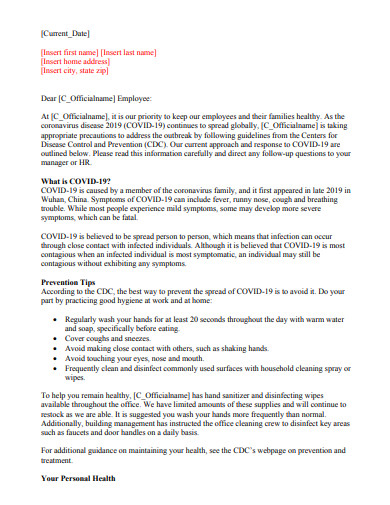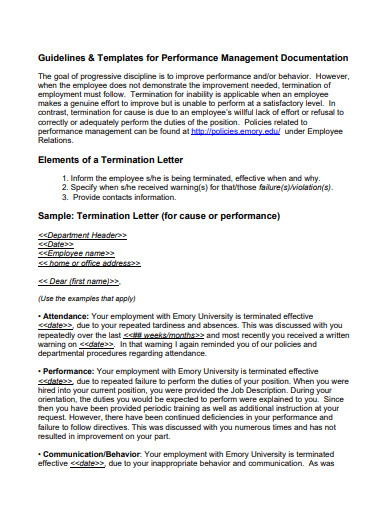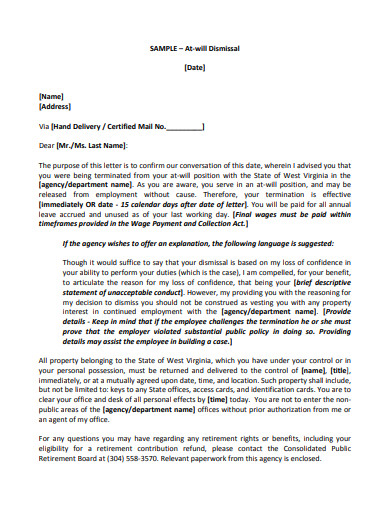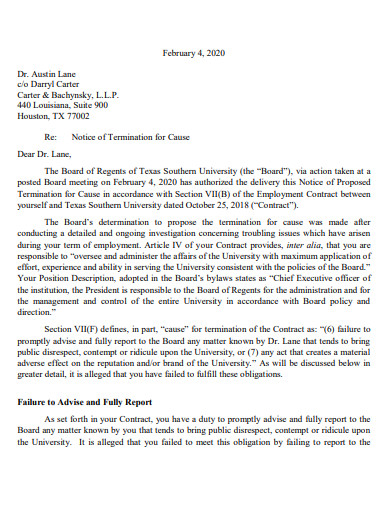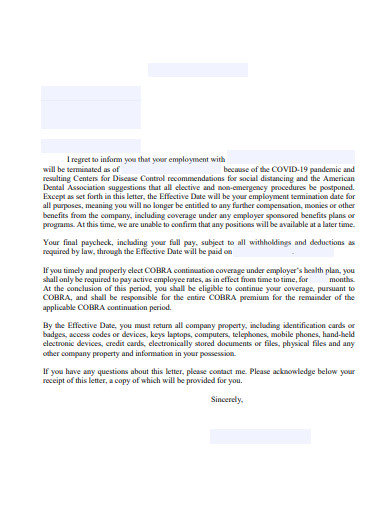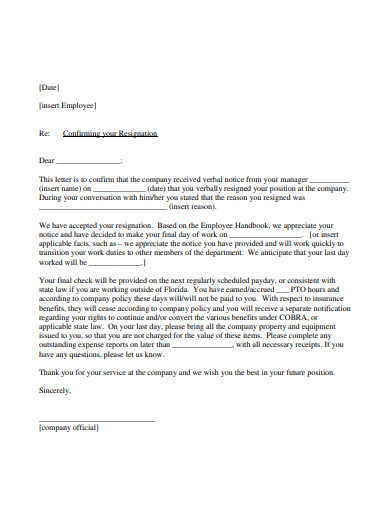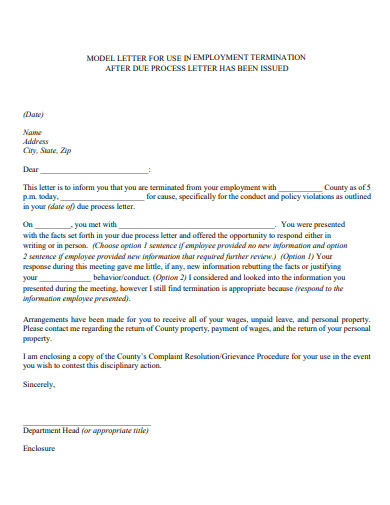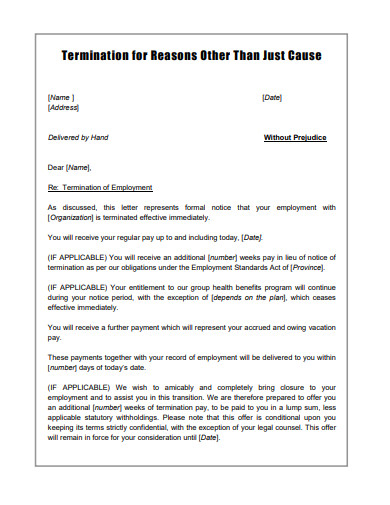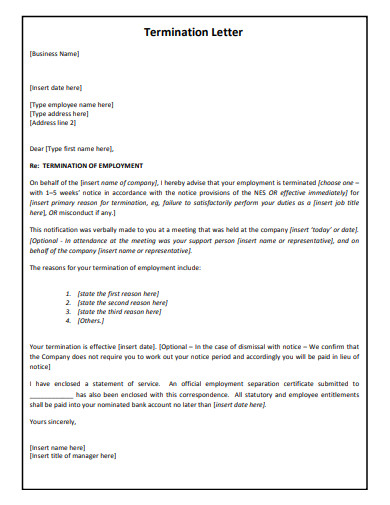10+ Employment Termination Letter Examples to Download
A 2019 study by CareerArc found that 40% of American workers have experienced being terminated or laid off from their jobs. It shows that employment termination is a common occurrence in the business world. Of course, ending the contract of employees isn’t easy. For one, it’ll badly affect their morale, and they could struggle to find other jobs. But whether you like it or not, terminating employees is sometimes necessary for the company’s benefit. And as an HR manager, it’s your job to do that when needed. When that time comes, you have to send them a termination notice through a formal letter. And for that, you’ll need our Employment Termination Letter Examples.
10+ Employment Termination Letter Examples
1. Free Employment Contract Termination Letter
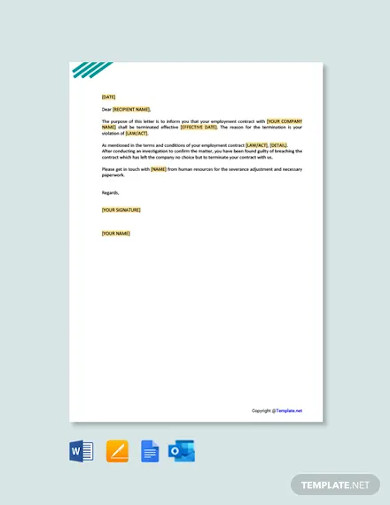
2. Free Appeal Letter for Termination of Employment
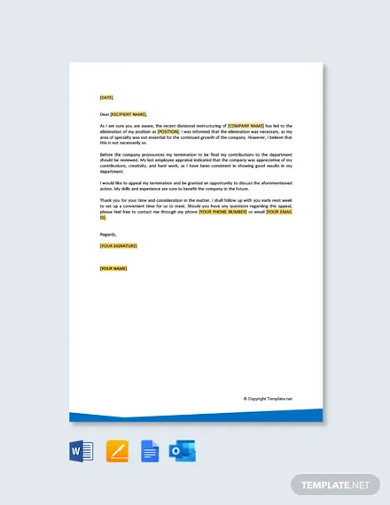
3. Employment Termination Letter Template
4. Sample Employment Termination Letter
5. Employment Termination Letter Example
6. University Employment Termination Letter
7. Blank Employment Termination Letter
8. Letter to Employee Confirming Termination
9. Employment Termination Letter in PDF
10. Termination of Employment Letter
11. Basic Employee Termination Letter
What Is an Employment Termination Letter?
An employment termination letter is a specific type of employee letter. It’s what most employers use to inform employees that their employment will soon end. Indeed, it’s a kind of letter that bears bad news for an employee. Employees who are subject to termination receive this letter two weeks or a month prior typically. Other terms for an employment termination letter are separation letter and contract termination letter.
Is It Necessary to Send an Employment Termination Letter?
Issuing an employment termination letter isn’t really mandatory. It depends on a company’s standard procedure in laying off or firing employees. But in our opinion, it’s better to issue it when an employee’s days in your company are numbered. For us, it’s more professional, and it shows a gesture of empathy.
Using a termination letter to inform employees of their termination allows you to pick the right words to say. We all understand the heavy feeling of losing a job. So at least ease their burden by making your message empathetic. Plus, informing them through a termination letter is one way to protect their privacy. It avoids the possibility of other employees gossiping about who’s going to leave the company.
How to Make an Employment Termination Letter
An employment termination letter is a highly confidential document. In a sense, it dictates an employee’s professional future, and it’s a future that they wish wouldn’t happen. With those in mind, you have to be careful in writing one. So, here we’ll give you a few tips in making an employment termination letter.
-
Go Straight to the Point
Receiving a notice letter from the HR department is already a nerve-racking feeling itself. That said, don’t prolong that kind of agony on the employee. In writing a termination letter, go straight to the point. Don’t dilly dally on other topics that has nothing to do with the matter at hand. Doing that prolongs the letter unnecessarily. Employment termination letters have to be short and concise.
-
Make Yourself Sound Sympathetic
When you write a termination letter, make yourself sound that you care for the employee’s feelings. Let the employee know that terminating him or her is nothing personal. And imply to the employee that your choice to end his or her employment was prompted due to the company’s current needs. Don’t let your message sound like it’s a subpar AI software that wrote it.
-
Explain the Reason Behind the Termination
If you’re going to terminate a worker, you should have a valid reason for doing so. It’s an employee’s right to know why the company is cutting ties with him or her. So make sure to explain the reason thoroughly. Justify it as much as you can with solid facts.
-
Offer Some Compensation
If the reason behind the termination isn’t due to poor performance or major violations, you should offer some compensation to the employee. An excellent one would be granting a severance or employment separation pay. Or out of goodwill, you can refer the employee to other employers who might need his or her services.
What are the two types of employment termination?
There are two types of employment termination. These are involuntary and voluntary termination.
Involuntary termination – is when the employee is relieved from his or her duties unwillingly. It could be that he or she was fired or simply laid off by the employer.
Voluntary termination – is when the employee leaves the company willingly. It could be that the employee went AWOL or the employee submitted a formal resignation.
What are valid reasons to terminate an employee?
These are the valid reasons to terminate an employee from the company:
- Company downsizing
- Stealing from company property
- Insubordination
- Incompetence
- Failure to protect confidential company data
- Dishonesty or fraud
What happens after an employee is terminated?
After an employee’s termination, what happens is that the employer should continue paying the employee’s remaining salary. The employer should also provide other forms of compensation that the company still owes the employee. Other than that, the company should also issue an employment certificate to the employee, and they must release other documents necessary for his or her next job.
Laying off good employees is probably the hardest decision that every HR manager makes. Employees are great assets for the company. But some circumstances mark them as liabilities, unfortunately. So when you’re faced with such a challenge, ease the hardship by writing a quality employment termination letter. Take advantage of our sample termination letter templates.



